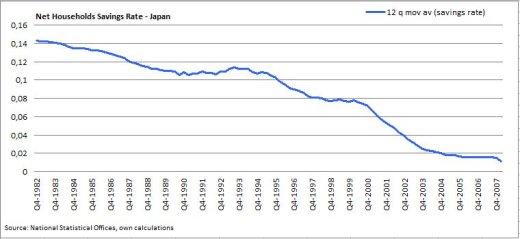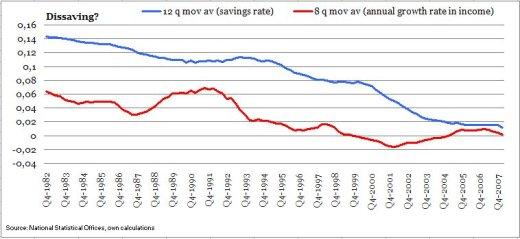In short, if the world economy is to get through this crisis in reasonable shape, credit worthy surplus countries must expand domestic demand relative to potential output. How they achieve this outcome is up to them. But only in this way can the deficit countries realistically hope to avoid spending themselves into bankruptcy.--Martin Wolf (2008)
It is not the first time that I am using this quote by the FT's chief economics commentator and I suspect it won't be the last. Of all the attempts by pundits and analysts to pinpoint the crux of the current crisis the observation above is the most important aspect in my opinion.
However, I disagree with Mr. Wolf in one critical aspect. Specifically, I don't think that this is simply a question of it being up to them, as it were, in terms of how export dependent/oriented economies may succeed in pushing their growth path onto one increasingly driven by domestic demand.
I believe that the export dependency of Germany and Japan (and a whole batch of economies which will now join them) are ultimately rooted in their demographic profiles where decades of below replacement fertility and rising life expectancy have now condemned them to an economic structure where the growth generated by domestic demand is virtually zero leaving external demand as the only meaningful way to create growth.
This does not mean that the combined external surpluses of these economies do not represent an important and potentially negative externality to the global economic system, but it does crucially mean that we cannot expect Japan, Germany et al to simply revert, through e.g. structural reforms, to a growth path driven by domestic demand that would allow them to suck up excess global capacity through an external deficit.
In order to focus the attention in this ongoing debate I will home in on Japan and concretely, a recent piece in which Martin Wolf actually fleshes out a specific way in which Japan would potentially be able to raise domestic demand to the benefit of herself and the global economy.
My own view is that the underlying structural problem has been the combination of excessive corporate savings (retained earnings) and diminished investment opportunities, once catch-up growth was over.
As Andrew Smithers of London-based Smithers & Co notes, Japan’s private non-residential fixed investment was 20 per cent of GDP in 1990, close to double the US share. This has fallen to 13 per cent after a modest resurgence in the 2000s. But no comparable decline has occurred in corporate retained earnings.
In the 1980s, the challenge of absorbing these savings was met by monetary policy, which drove the cost of borrowing to zero and sustained wasteful investment. In the 2000s, the challenge was met by an export and investment boom, driven largely by trade with China.
Japan’s aim now must be to achieve domestically-driven growth. The most important requirement is a big reduction in corporate saving. I would add that if ever an economy needed a market in corporate control, to shift cash out of the hands of sleepy managements, Japan is it.
Not being beholden to Japan’s corporate establishment, the new government should adopt policies that would change corporate behavior, at last.
What follows is my take on this argument seen through the lens of a detailed look at the savings behavior of households and corporates in Japan.
Household Savings - (Dis)saving in Japan?
Standard life cycle theory states that consumers run down their assets into old age (dis-save) and thus that a rapidly ageing society at some point should move into a state of perpetual dis-saving with the consequence in an open economy context being an external deficit (eventually).
However, both in theory and in practice this is not so simple and Japan is a good example here. In this way and while the household savings rate (out of labor income) has indeed plummeted in Japan, the economy still has a large and persistent external surplus.
Since we know that the government is mired in both current and future debt this has, by definition, to reflect a high level of corporate savings.
Thus and with a low savings rate in the household sector the reduction in corporate savings holds perhaps the biggest potential for releasing domestic demand in Japan or so at least is the crux of Martin Wolf' argument as I see it [1].

Most analyses on household saving rates in Japan do not move beyond the representation above which plots net savings as a share of net income.
And indeed, this paints an unequivocal picture. The quarterly figure is highly volatile and subject to notable seasonality, but smoothed through a 12 quarter moving average shows us that since 2000 the savings rate of Japanese households have not exceeded 5 percent.
More interesting is the relentless downward trend which shows, more than anything, that the real economic conditions for Japanese households have changed significantly.
This perspective which looks at the flow of savings is strongly underpinned by many empirical studies on the savings behavior of Japanese households.
Since 1997 the growth rate in GDP and private consumption expenditures have languished at a depressing mean reverting trend around the zero percentage annual growth mark.
This indicates quite clearly that whatever the extent to which aging households in Japan have dis-saved through increasing consumption expenditures it has not been any meaningful driving force of consumption.
But what about the other two (increase in taxes and social insurance premiums). Are these really dis-saving? I don't think so.
Rather, these represent a transfer of saving from households to the government and thus an attempt by part of the government to reduce the future cost of age-related liabilities and thus to compensate for a strongly negative net asset position.
In an aging economy this is exactly why we would expect the dis-saving hypothesis to be in need of significant adjustment since there will be forced savings through the inevitable attempt by the government to stabilize the deteriorating fiscal situation.
As such, the representation above does not paint an adequate picture of household savings in Japan and while this initially may be explained in light of the fact that we should look at the savings of the entire Japananese consumer base and not only the elderly (retired) consumers, the rapid and ongoing process of ageing in Japan means that these two argument will inevitably converge over time.
Specifically, the account of dis-saving above fails to take into account, at least, two important missing links. The first is the simple fact that the rate of savings out of total income is closely related to the annual growth in income which, in Japan's case, has exactly declined significantly in the same period in part because of the deflationary environment but also, I would argue, to reflect the changing productivity structure of the Japanese labor market with an ageing work force.

Between 1998 and 2005 the change in the annual income flow to Japanese households was persistently negative and suddenly; a consistent savings rate in the same period of about 3-5 percent does not exactly come off as rapid dis-saving.
In fact, at no point in the graph above has the savings rate been below the annual growth in income which provides a very important qualifying perspective to the idea that the release of corporate savings either as a lump sum transfer or through a steady trickle of dividends would immediately be channeled into discretionary spending.
I find this very difficult to believe, but in effect this will be subject to easy falsification if and when corporate savings in Japan became an important policy variable in terms of stimulating domestic demand.
The second missing link relates to the idea that savings may be defined in two overall ways, the first which is a flow perspective is described above and the second is a stock perspective.
The best example of the latter is the asset meltdown hypothesis that envisions a sharp decline in asset prices as aged households grind down their stock of assets by selling them to a smaller and shrinking base of working age households who will not be numerous or wealthy enough to support asset prices at the given level.
In the context of Japan, I have argued before how there is no meaningful destocking of assets even if the growth of households' total assets have stalled significantly.
Between 1997 and 2009 the overall household balance sheet in Japan has remained pretty "stable" rising from Y1285 trillion in 1997 to about Y1440 trillion in 2009 (current prices).
I choose to put stable in quotations mark here since the real thing to notice is the lack of expansion (i.e. debt-driven asset expansions) by part of Japanese households to reflect the fact that there was no housing bubble let alone any other kind of bubble in Japan in the period in question.
The main point is of course that despite a continuing decline in the rate of savings from a flow perspective, Japanese households are not (yet!) engaged in any meaningful de-stocking towards whatever end point the economy would reach if aging households and indeed the society as a whole began to run down its stock of savings.
Moreover, it is remarkable to see that the amount of currency held by Japanese households has increased by 40% in the same period. This suggests, more than anything, the risk aversion of Japanese households.
Finally, I think it is worth to mention that although the amount of bonds held directly by Japanese households is next to none, Japanese households are naturally doing a substantial part of the heavy lifting in terms of financing the ongoing and almost perpetual deficit spending by part of Japan's governments.
In this way, the large bulk of deposits as well as insurance and pension funds are very likely to be substantially invested (de-facto) in Japanese government bonds.
As an interim conclusion, and while a first glance suggests that Japan indeed is dis-saving through its household sector, it is an argument which does not hold entirely up to scrutiny.
It is important for me to emphasize two things. Firstly, I don't dispute the analysis in Horioka (2009) and thus the wide range of previous studies that have shown how the life cycle model of savings is well calibrated to a Japanese context.
However, I do think it is important to differentiate it with the points above and particularly the notion that Japanese households, as a whole, do not seem to be rapidly dis-saving to the extent that many claim.
Secondly, I want to reiterate the point that I am not arguing that dis-saving will never occur in the aggregate. What I am saying however is that looking at the dis-saving of the elderly and concluding that this will lead Japan towards an external current account deficit misses the current and real effect from aging in Japan.
Consequently, the picture of Japan at the present time running an almost perpetual external surplus is one of an economy fighting like hell to avoid obvious end point that would occur in the event of rapid de-stocking/dis-saving.
Is it Optimal to Dis-save?
The standard life cycle model tells us that it clearly is, and especially so when set in the context of a representative agent model aggregated to the macroeconomic level.
Sure, we may incorporate bequest motives or uncertainty, but in the limit; dis-saving on a microeconomic level will transfer itself to the macroeconomic level.
Implicitly, this is the argument advanced when it is held that the retained earnings of Japanese companies can meaningfully be deployed to boost domestic demand in Japan and, most importantly, lead Japan towards an external deficit which would go some way to rebalance the global economy.
Let me be clear. I don't dispute the dis-saving argument in itself; especially in a context where fertility "never" recovers (which may well be the practical case in Japan).
However, and while dis-saving certainly would be the fate for a closed economy, it need not be for an open one. In fact, it should take us very little time to agree that dis-saving as a function of old age perhaps even to the extent that the economy moves into an external deficit is utterly undesirable from the point of view of the economy as a whole.
Thus, it is my contention that aging societies are not, in the main, characterised by aggregate dis-saving but rather by the fight against it. In Japan's case the high level of private savings reflected primarily in the level of corporate savings becomes a vital shield towards spinning further into negative trend growth and deflation.
Meanwhile, the eurozone as a whole, having lost its erstwhile internal demand engines, must now hope for faster growth of net exports. So do countries hit by the financial shock, such as the UK and US. So, too, does recession-hit Japan.
So, not least, does China. Either the rest of the world has a spending binge, or these countries – which make up 70 per cent of the world economy – are going to be disappointed.
This seems self-defeating to me since there is no way that 70% of the world economy can rely on export driven recoveries let alone export-driven growth strategies no matter what kind of binge came upon the rest of the world. Still, I completely agree with Martin that this is indeed the issue.
And once you overlay this argument with some basic intuition of how demographics affect savings, consumption and investment you end up with the fundamental challenge for the global economy in terms of staging a comeback from the economic crisis.
So yes Virginia, demographics do matter!
---
List of References
Data for this piece can be obtained by mailing me and I will ship over my excel sheets. However, for those of you who want to check it out yourself here is the database on the corporate balance sheet data and in terms of household data you can get it from the website of the Bank of Japan (search for "household" and you should be able to dig out the relevant files).
Baldwin, Richard & Taglioni, Daria (2009) – The Illusion of Improving Global Imbalances, VoxEU research article (14.11.09) http://www.voxeu.org/index.php?q=node/4209
Friend, Andrew (1985) - The Policy Options for Stimulating National Savings, Conference on Saving and Capital Formation: The Policy Options Philadelphia (May 1985)
Obstfeld, Maurice & Rogoff, Kenneth (2009) – Global Imbalances and the Financial Crisis: Product of Common Causes, Paper prepared for the Federal Reserve Bank of San Francisco Asia Economic Policy Conference, Santa Barbara, CA, October 18-20, 2009
Horioka Yuji, Charles (2009) - The (Dis)saving Behavior of the Aged in Japan, Discussion Paper no. 763 The institute of Social and Economic Research Osaka University
Other posts by Claus Vistesen:







